2018北京大学翻译硕士MTI真题
2018年翻译硕士考研英语练习题及答案
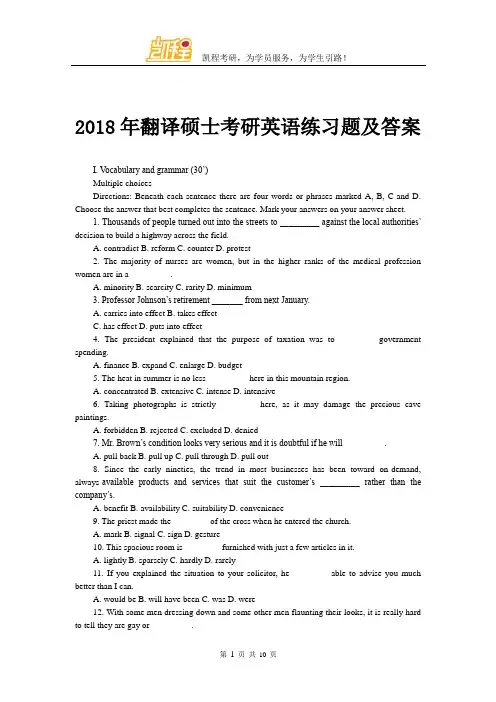
2018年翻译硕士考研英语练习题及答案I. V ocabulary and grammar (30’)Multiple choicesDirections: Beneath each sentence there are four words or phrases marked A, B, C and D. Choose the answer that best completes the sentence. Mark your answers on your answer sheet.1. Thousands of people turned out into the streets to _________ against the local authorities’ decision to build a highway across the field.A. contradictB. reformC. counterD. protest2. The majority of nurses are women, but in the higher ranks of the medical profession women are in a _________.A. minorityB. scarcityC. rarityD. minimum3. Professor Johnson’s retirement _______ from next January.A. carries into effectB. takes effectC. has effectD. puts into effect4. The president explained that the purpose of taxation was to ________ government spending.A. financeB. expandC. enlargeD. budget5. The heat in summer is no less _________ here in this mountain region.A. concentratedB. extensiveC. intenseD. intensive6. Taking photographs is strictly ________ here, as it may damage the precious cave paintings.A. forbiddenB. rejectedC. excludedD. denied7. Mr. Brown’s condition looks very serious and it is doubtful if he will _________.A. pull backB. pull upC. pull throughD. pull out8. Since the early nineties, the trend in most businesses has been toward on-demand, always-available products and services that suit the customer’s _________ rather than the company’s.A. benefitB. availabilityC. suitabilityD. convenience9. The priest made the ________ of the cross when he entered the church.A. markB. signalC. signD. gesture10. This spacious room is ________ furnished with just a few articles in it.A. lightlyB. sparselyC. hardlyD. rarely11. If you explained the situation to your solicitor, he ________ able to advise you much better than I can.A. would beB. will have beenC. wasD. were12. With some men dressing down and some other men flaunting their looks, it is really hard to tell they are gay or _________.A. straightB. homosexualC. beautifulD. sad13. His remarks were ________ annoy everybody at the meeting.A. so as toB. such as toC. such toD. as much as to14. James has just arrived, but I didn’t know he _________ until yesterday.A. will comeB. was comingC. had been comingD. came15. _________ conscious of my moral obligations as a citizen.A. I was and always will beB. I have to be and always will beC. I had been and always will beD. I have been and always will be16. Because fuel supplies are finite and many people are wasteful, we will have to install _________ solar heating device in our home.A. some type ofB. some types of aC. some type of aD. some types of17. I went there in 1984, and that was the only occasion when I ________ the journey in exactly two days.A. must takeB. must have madeC. was able to makeD. could make18. I know he failed his last test, but really he’s _________ stupid.A. something butB. anything butC. nothing butD. not but19. Do you know Tim’s brother? He is _________ than Tim.A. much more sportsmanB. more of a sportsmanC. more of sportsmanD. more a sportsman20. That was not the first time he ________ us. I think it’s high time we ________ strong actions against him.A. betrayed… takeB. had betrayed… tookC. has betrayed… tookD. has betrayed… takeII. Reading comprehension (40’)Section 1 multiple choice (20’)Directions: In this section there are reading passages followed by multiple-choice questions. Read the passages and then mark your answers on your answer sheet.Passage AThe Welsh language has always been the ultimate marker of Welsh identity, but a generation ago it looked as if Welsh would go the way of Manx, once widely spoken on the Isle of Man but now extinct. Governments financing and central planning, however, have helped reverse the decline of Welsh. Road signs and official public documents are written in both Welsh and English, and schoolchildren are required to learn both languages. Welsh is now one of the most successful of Europe’s regional languages, spoken by more than a half-million of the country’s three million people.The revival of the language, particularly among young people, is part of a resurgence of national identity sweeping through this small, proud nation. Last month Wales marked the second anniversary of the opening of the National Assembly, the first parliament to be convened here since 1404. The idea behind devolution was to restore the balance within the union of nations making up the United Kingdom. With most of the people and wealth, England has always hadbragging rights. The partial transfer of legislative powers from Westminster, implemented by Tony Blair, was designed to give the other members of the club—Scotland, Northern Ireland, and Wales—a bigger say and to counter centrifugal forces that seemed to threaten the very idea of the union.The Welsh showed little enthusiasm for devolution. Whereas the Scots voted overwhelmingly for a parliament, the vote for a Welsh assembly scraped through by less than one percent on a turnout of less than 25 percent. Its powers were proportionately limited. The Assembly can decide how money from Westminster or the European Union is spent. It cannot, unlike its counterpart in Edinburgh, enact laws. But now that it is here, the Welsh are growing to like their Assembly. Many people would like it to have more powers. Its importance as figurehead will grow with the opening in 2003, of a new debating chamber, one of many new buildings that are transforming Cardiff from a decaying seaport into a Baltimore-style waterfront city. Meanwhile a grant of nearly two million dollars from the European Union will tackle poverty. Wales is one of the poorest regions in Western Europe—only Spain, Portugal, and Greece have a lower standard of living.Newspapers and magazines are filled with stories about great Welsh men and women, boosting self-esteem. To familiar faces such as Dylan Thomas and Richard Burton have been added new icons such as Catherine Zeta-Jones, the movie star, and Bryn Terfel, the opera singer. Indigenous foods like salt marsh lamb are in vogue. And Wales now boasts a national airline, Awyr Cymru. Cymru, which means “land of compatriots”, is the Welsh name for Wales. The red dragon, the nati on’s symbol since the time of King Arthur, is everywhere—on T-shirts, rugby jerseys and even cell phone covers.“Until very recent times most Welsh people had this feeling of being second-class citizens,” said Dyfan Jones, an 18-year-old student. It was a warm summer night, and I was sitting on the grass with a group of young people in Llanelli, an industrial town in the south, outside the rock music venue of the National Eisteddfod, Wales’s annual cultural festival. The disused factory in front of us echoed to the sounds of new Welsh bands.“There was almost a genetic tendency for lack of confidence,” Dyfan continued. Equally comfortable in his Welshness as in his membership in the English-speaking, global youth culture and the new federal Europe, Dyfan, like the rest of his generation, is growing up with a sense of possibility unimaginable ten years ago. “We used to think. We can’t do anything, we’re only Welsh. Now I think that’s changing.”1. According to the passage, devolution was mainly meant toA. maintain the present status among the nations.B. reduce legislative powers of England.C. create a better state of equality among the nations.D. grant more say to all the nations in the union.2. The word “centrifugal” in the second paragraph meansA. separatist.B. conventional.C. feudal.D. political3. Wales is different from Scotland in all the following aspects EXCEPTA. people’s desire for devolution.B. locals’ turnout for the voting.C. powers of the legislative body.D. status of the national language.4. Which of the following is NOT cited as an example of the resurgence of Welsh national identity?A. Welsh has witnessed a revival as a national language.B. Poverty-relief funds have come from the European Union.C. A Welsh national airline is currently in operation.D. The national symbol has become a familiar sight.5. According to Dyfan Jones what has changed isA. people’s mentality.B. pop culture.C. town’s appearance.D. possibilities for the people.Passage BThe miserable fate of Enron’s employees will be a landmark in business history, one of those awful events that everyone agrees must never be allowed to happen again. This urge is understandable and noble: thousands have lost virtually all their retirement savings with the demise of Enron stock. But making sure it never happens again may not be possible, because the sudden impoverishment of those Enron workers represents something even larger than it seems. It’s the latest turn in the unwinding of one of the most audacious promises of the 20th century.The promise was assured economic security—even comfort—for essentially everyone in the developed world. With the explosion of wealth, that began in the 19th century it became possible to think about a possibility no one had dared to dream before. The fear at the center of daily living since caveman days—lack of food, warmth, shelter—would at last lose its power to terrify. That remarkable promise became reality in many ways. Governments created welfare systems for anyone in need and separate programs for the elderly (Social Security in the U.S.). Labor unions promised not only better pay for workers but also pensions for retirees. Giant corporations came into being and offered the possibility—in some cases the promise—of lifetime employment plus guaranteed pensions? The cumulative effect was a fundamental change in how millions of people approached life itself, a reversal of attitude that most rank as one of the largest in human history. For millennia the average person’s stance toward providing for himself had been. Ultimately I’m on my own. Now it became, ultimately I’ll be taken care of.The early hints that this promise might be broken on a large scale came in the 1980s. U.S. business had become uncompetitive globally and began restructuring massively, with huge Layoffs. The trend accelerated in the 1990s as the bastions of corporate welfare faced reality. IBM ended its no-layoff policy. AT&T fired thousands, many of whom found such a thing simply incomprehensible, and a few of whom killed themselves. The other supposed guarantors of our economic security were also in decline. Labor-union membership and power fell to their lowest levels in decades. President Clinton signed a historic bill scaling back welfare. Americans realized that Socia l Security won’t provide social security for any of us.A less visible but equally significant trend affected pensions. To make costs easier to control, companies moved away from defined benefit pension plans, which obligate them to pay out specified amounts years in the future, to defined contribution plans, which specify only how much goes into the play today. The most common type of defined-contribution plan is the 401(k). the significance of the 401(k) is that it puts most of the responsibility for a pe rson’s economic fate back on the employee. Within limits the employee must decide how much goes into the plan each year and how it gets invested—the two factors that will determine how much it’s worth when the employee retires.Which brings us back to Enron? Those billions of dollars in vaporized retirement savings went in employees’ 401(k) accounts. That is, the employees chose how much money to put into those accounts and then chose how to invest it. Enron matched a certain proportion of each employee’s 401(k) contribution with company stock, so everyone was going to end up with some Enron in his or her portfolio; but that could be regarded as a freebie, since nothing compels a company to match employee contributions at all. At least two special features complicate the Enron case. First, some shareholders charge top management with illegally covering up the company’s problems, prompting investors to hang on when they should have sold. Second, Enron’s 401(k) accounts were locked while the company changed pla n administrators in October, when the stock was falling, so employees could not have closed their accounts if they wanted to.But by far the largest cause of this human tragedy is that thousands of employees were heavily overweighed in Enron stock. Many had placed 100% of their 401(k) assets in the stock rather than in the 18 other investment options they were offered. Of course that wasn’t prudent, but it’s what some of them did.The Enron employees’ retirement disaster is part of the larger trend away fro m guaranteed economic security. That’s why preventing such a thing from ever happening again may be impossible. The huge attitudinal shift to I’ll-be-taken-care-of took at least a generation. The shift back may take just as long. It won’t be complete until a new generation of employees see assured economic comfort as a 20th-century quirk, and understand not just intellectually but in their bones that, like most people in most times and places, they’re on their own.6. Why does the author say at the beginnin g “The miserable fate of Enron’s employees will be a landmark in business history…”?A. Because the company has gone bankrupt.B. Because such events would never happen again.C. Because many Enron workers lost their retirement savings.D. Because it signifies a turning point in economic security.7. According to the passage, the combined efforts by governments, layout unions and big corporations to guarantee economic comfort have led to a significant change inA. people’s outlook on life.B. people’s life styles.C. people’s living standard.D. people’s social values.8. Changes in pension schemes were also part ofA. the corporate lay-offs.B. the government cuts in welfare spending.C. the economic restructuring.D. the warning power of labors unions.9. Thousands of employees chose Enron as their sole investment option mainly becauseA. the 401(k) made them responsible for their own future.B. Enron offered to add company stock to their investment.C. their employers intended to cut back on pension spending.D. Enron’s offer was similar to a defined-benefit plan.10. Which is NOT seen as a lesson drawn from the Enron disaster?A. The 401(k) assets should be placed in more than one investment option.B. Employees have to take up responsibilities for themselves.C. Such events could happen again as it is not easy to change people’s mind.D. Economic security won’t be taken for granted by future young workers.Section 2 Answering questions (20’)Directions: Read the following passages and then answer IN COMPLETE SENTENCES the questions which follow each passage. Use only information from the passage you have just read and write your answer in the corresponding space in your answer sheet.Questions 1~3For 40 years the sight of thousands of youngsters striding across the open moorland has been as much an annual fixture as spring itself. But the 2,400 school pupils who join the grueling Dartmoor Ten Tors Challenge next Saturday may be among the last to take part in the May tradition. The trek faces growing criticism from environmentalists who fear that the presence of so many walkers on one weekend threatens the survival of some of Dartmoor’s internationally rare bird species.The Ten Tors Challenge takes place in the middle of the breeding season, when the slightest disturbance can jeopardize birds’ chances of reproducing successfully. Experts at the RSPB and the Dartmoor National Park Authority fear that the walkers could frighten birds and even crush eggs. They are now calling for the event to be moved to the autumn, when the breeding season is over and chicks should be well established. Organisers of the event, which is led by about 400 Territorial Army volunteers, say moving it would be impractical for several reasons and would mean pupils could not train properly for the 55-mile trek. Dartmoor is home to 10 rare species of ground-nesting birds, including golden plovers, dunlins and lapwings. In some cases, species are either down to their last two pairs on the moor or are facing a nationwide decline.Emma Parkin, South-west spokeswoman for the PASPB, took part in the challenge as a schoolgirl. She said the society had no objections to the event itself but simply wanted it moved to another time of year. “It is a wonderful activity for the children who take part bu t, having thousands of people walking past in one weekend when birds are breeding is hardly ideal,” she said. “We would prefer it to take place after the breeding and nesting season is over. There is a risk of destruction and disturbance. If the walkers put a foot in the wrong place they can crush the eggs and if there is sufficient disturbance the birds might abandon the nest.” Helen Booker, an RSPB upland conservation officer, said there was no research into the scale of the damage but there was little do ubt the walk was detrimental. “If people are tramping past continually it can harm the chances of successful nesting. There is also the fear of direct trampling of eggs.” A spokesman for the Dartmoor National Park Authority said the breeding season on the moor lasted from earlyMarch to mid-July, and the Ten Tors Challenge created the potential for disturbance for March, when participants start training.To move the event to the autumn was difficult because children would be on holiday during the training period. There was a possibility that some schools in the Southwest move to a four-term year in 2004, “but until then any change was unlikely. The authority last surveyed bird life on Dartmoor two year ago and if the next survey showed any further decline, it would increase pressure to move the Challenge,” he said.Major Mike Pether, secretary of the army committee that organises the Challenge, said the event could be moved if there was the popular will. “The Ten Tors has been running for 42 years and it has always been at this time of the year. It is almost in tablets of stone but that’s not to say we won’t consider moving if there is a consensus in favour. However, although the RSPB would like it moved, 75 per cent of the people who take part want it to stay as it is,” he said. Major Pether said the trek could not be moved to earlier in the year because it would conflict with the lambing season, most of the children were on holiday in the summer, and the winter weather was too harsh.Datmoor National Park occupies some 54 sq km of hills topped by granite outcrops known as “Tors” with the highest Tor-capped hill reaching 621m. The valleys and dips between the hills are often sites of bogs to snare the unwary hiker. The moor has long been used by the British Army as a training and firing range. The origin of the event stretches back to 1959 when three Army officers exercising on the moor thought it would provide a challenge for civilians as well as soldiers. In the first year 203 youngsters took up the challenges. Since then teams, depending on age and ability, face hikes of 35, 45 or 55 miles between 10 nominated Tors over two days. They are expected to carry everything they need to survive.1. What is the Ten Tors Challenge? Give a brief introduction of its location and history.2. Why is it suggested that the event be moved to the autumn or other seasons?3. What are the difficulties if the event is moved to the autumn or other seasons?Questions 4~5Mike and Adam Hurewitz grew up together on Long Island, in the suburbs of New York City. They were very close, even for brothers. So when Adam’s liver started failing, Mike offered to give him half of his. The operation saved Adam’s life. But Mike, who went into the hospital in seemingly excellent health, developed a complication—perhaps a blood colt—and died last week. He was 57. Mike Hurewitz’s death has prompted a lot of soul searching in the transplant community. Was it a tragic fluke or a sign that transplant surgery has reached some kind of ethical limit? The Mount Sinai Medical Center, the New York City hospital where the complex double operation was performed, has put on hold its adult living donor liver transplant program, pending a review of Hurewitz’s death. Mount Sinai has performed about 100 such operation s in the past three years.A 1-in-100 risk of dying may not seem like bad odds, but there’s more to this ethical dilemma than a simple ratio. The first and most sacred rule of medicine is to do no harm. “For a normal healthy person a mortality rate 1% is h ard to justify,” says Dr. John Fung, chief of transplantation at the University of Pittsburgh Medical Center. “If the rate stays at 1%, it’s just not going to be accepted.” On the other hand, there’s an acute shortage of traditional donor organs from people who have died in accidents or suffered fatal heart attacks. If family members fullyunderstand the risks and are willing to proceed, is there any reason to stand in their way? Indeed, a recent survey showed that most people will accept a mortality rate for living organ donors as high as 20%. The odds, thankfully, aren’t nearly that bad. For kidney donors, for example, the risk ranges from 1 in 2, 500 to 1 in 4, 000 for a healthy volunteer. That helps explain why nearly 40% of kidney transplants in the U.S. come from living donors.The operation to transplant a liver, however, is a lot trickier than one to transplant a kidney. Not only is the liver packed with blood vessels, but it also makes lots of proteins that need to be produced in the right ratios for the body to survive. When organs from the recently deceased are used, the surgeon gets to pick which part of the donated liver looks the best and to take as much of it as needed. Assuming all goes well, a healthy liver can grow back whatever portion of the organ is missing, sometimes within a month.A living-donor transplant works particularly well when an adult donates a modest portion of the liver to a child. Usually only the left lobe of the organ is required, leading to a mortality rate for living-donors in the neighborhood of 1 in 500 to 1 in 1, 000. But when the recipient is another adult, as much as 60% of the donor’s liver has to be removed. “There really is very little margin for error,” says Dr. Fung. By way of analogy, he suggests, think of a tree. “An adult-to-child living-donor transplant is like cutting off a limb. With an adult-to-adult transplant, you’re splitting the trunk in half and trying to keep both halves alive.”Even if a potential donor understand and accepts these risks, that doesn’t necessarily mean the operation should proceed. All sorts of subtle pressures can be brought to bear on such a decision, says Dr. Mark Siegler, director of the MacLean for Clinical Medical Ethics at the University of Chicago. “Sometimes the sicker the pa tient, the greater the pressure and the more willing the donor will be to accept risks.” If you feel you can’t say no, is your decision truly voluntary? And if not, is it the medical community’s responsibility to save you from your own best intentions?Transplant centers have developed screening programs to ensure that living donors fully understand the nature of their decision. But unexamined, for the most part, is the larger issue of just how much a volunteer should be allowed to sacrifice to save another human being. So far, we seem to be saying some risk is acceptable, although we’re still vaguer about where the cutoff should be. There will always be family members like Mike Hurewitz who are heroically prepared to make the ultimate sacrifice for a loved one. What the medical profession and society must decide is if it’s appropriate to let them do so.4. Describe in your own words the liver transplant between the two brothers Mike and Adam.5. What is the major issue raised in the article?III. Writing (30’)Some people see education simply as going to school or college, or as a means to secure good jobs; other people view education as a lifelong process. In your opinion, how important is education to people in the modern society?Write a composition of about 400 words on your view of the topic.翻译硕士英语模练习参考答案I. V ocabulary and grammar (30’)1-10 DABAC ACDDB11-20 AABBD ACBBCII. Reading comprehension (40’)Section 1 Multiple choice (20’)1. C2. A3. D4. B5. A6. D7. A8. C9. B 10. BSection 2 Answe ring questions (20’)Key points1. located in Dartmoor Park/with 54 sq km of hills covered by “Tors”/an event starting from 1959/young people walking over a distance of 55-mile trek in two days/in Spring (May)/ a kind of outdoor physical training2. enviro nmentalism/threatening of some “internationally rare bird species”/breeding season/nesting season/destroying eggs/frightening birds/declining of birds3. if moved to autumn/children “on holiday” during the training period/majority unwilling to change the time/if moved earlier: lambing season/winter: too harsh and cold4. Mike and Adam/one’s liver “failing”, Mike donated half of his liver/Adam survived/Mike, the healthy brother, due to the “complication” developed in the operation, died after the successful transplant5. when there is a risk of donors’ dying from organ transplant between family members/1 in 100 risk/higher or lower/Shall such transplant operations be encouraged?/different viewpoints/heated argumentIII. Writing (30’)Education as a Lifelong ProcessWhen we talk about education, we can easily think of schools, colleges and young people. As a matter of fact, education is so important in modern society that it can be viewed as a lifelong process.Firstly, it’s the requirement of fast-developing society to receive education despite of your age. Our world is changing dramatically with the development of new science and technology. A person who completed his education at school in the 1970s or the 1980s may have encountered new problems when he is working now. The problems might have something to do with his major or other aspects. For example an accountant now must master the skills of accounting through computers, which is a basic tool for him, so he should also learn how to apply his job in a computer no matter how old he is.Secondly, education creates human character and moralities. Through education, youth may learn how to make contributions to the world. And the old may learn new things to enrich their lives. Through education, a healthy person can become stronger and a disabled person can have a new hope on his life. Man can find great pleasure in education.Thirdly, our modem society has provided everyone with the chance to receive education. As long as you wish you could get education by attending night-schools, adult colleges, trainingcenters and even long-distance education through Internet and TV.In a word, knowledge is boundless, and life is limited. So education is a lifelong process.。
北京大学翻译硕士考研真题及答案
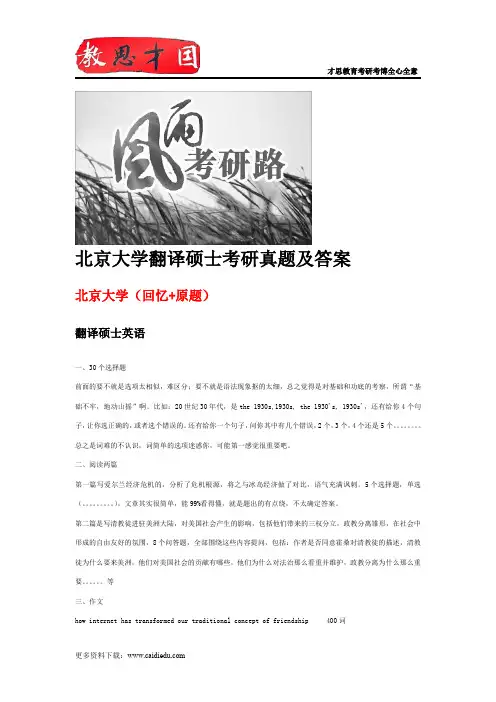
三、命题作文 800 字 写博客或评论 QQ 和 360 之争
才思教育考研考博全心全意
更多资料下载:
汉语写作与百科知识
一、25 个名词解释: 1.洋务运动 2.百日维新 3.北洋水师 4.五月花号 5.玫瑰战争 6.滞涨 7.马建忠 8.十二铜表
更多资料下载:
9.马其诺防线 10.直接民主 11.陪审团 12.山顶洞人 13.贸易顺差 14.自由宪章 15.荷马史诗 16.免罪推论 17.圈地运动 18.失乐园 19.利维坦 20.帕累托改进 21.刘易斯拐点 22.波士顿倾茶事件
更多资料下载:
才思教育考研考博全心全意
念夏洛蒂的文章《最后一幅素描》中说 :“凡是读过她的书的人,谁不钦佩这位妇 女对真理的炽热的爱,她的 勇敢,她的纯真,她对邪恶的义愤,她热切的同情心,她虔诚的爱和信仰,她激越的荣誉感。一种急切的诚实是 这位妇女的性格特征。”这段话可以说是夏洛蒂的真实写照。
英语翻译基础
一、词语翻译(30 个) reciprocal banquet talk show black tea Byzantine Empire Sanitery ware WHO CIA CNN HDTV CPU CBS…… 艾滋病毒 应用语言学 国际货币基金组织 爵士摇滚 入境签证
二、十个中文术语中译英 美国联邦储备银行 拜占庭帝国 在餐馆干杂活的小工 谋杀未遂 核裁军 减免学杂费 经济指标
因为不愿意暴露身分,所以我们用库瑞尔、艾利斯、阿克顿贝尔这些笔名来隐藏本名。这个因为良心不 安而做出的暧昧抉择,是假设基督徒对于名为男性的思考是正面的。我们并不喜欢宣布我们是女人,因 为——毫无疑问的,我们的著作和思想是不会被称为“女注意到评论家有时是如何因为个性而抨击,有时则是用谄媚当作鼓励,这些 并不是真正的评价。
2018北京大学翻译硕士MTI真题
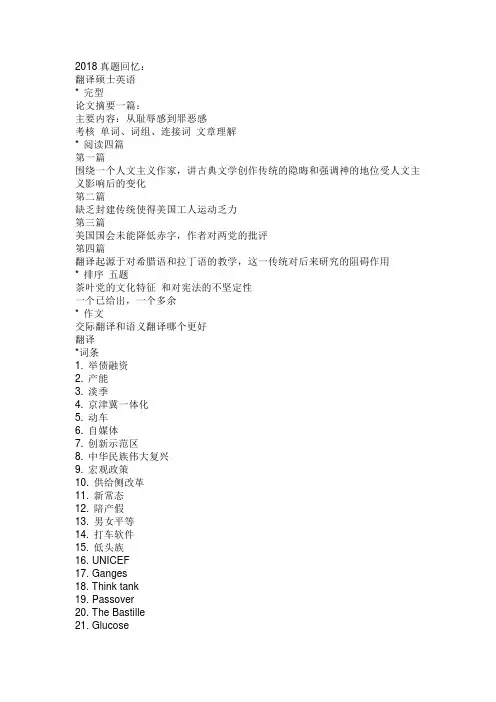
2018真题回忆:翻译硕士英语* 完型论文摘要一篇:主要内容:从耻辱感到罪恶感考核单词、词组、连接词文章理解* 阅读四篇第一篇围绕一个人文主义作家,讲古典文学创作传统的隐晦和强调神的地位受人文主义影响后的变化第二篇缺乏封建传统使得美国工人运动乏力第三篇美国国会未能降低赤字,作者对两党的批评第四篇翻译起源于对希腊语和拉丁语的教学,这一传统对后来研究的阻碍作用* 排序五题茶叶党的文化特征和对宪法的不坚定性一个已给出,一个多余* 作文交际翻译和语义翻译哪个更好翻译*词条1. 举债融资2. 产能3. 淡季4. 京津冀一体化5. 动车6. 自媒体7. 创新示范区8. 中华民族伟大复兴9. 宏观政策10. 供给侧改革11. 新常态12. 陪产假13. 男女平等14. 打车软件15. 低头族16. UNICEF17. Ganges18. Think tank19. Passover20. The Bastille21. Glucose22. Republicanism23. surrealism24. procrastination25. tipping point26. Chiang Kai-shek27. Kilimanjaro28. avant-garde29. Notre Dame de Paris30. Academy Reward英译汉话题:历法汉译英话题:生态文学百科1.25个选择(每个一分)实在记不全,都是参考书里的,西方哲学、翻译理论、翻译项目管理、《中国翻译》上的文章都有考。
记得的有:下面哪个关于“逻各斯”的说法不对文化翻译的原则《弗兰恩斯坦》的作者傅雷翻译观第五次科技革命的成果中国翻译发展的特点大数据的特点2. 论述(每个5分)最后5个选择完还要用300字回答提问1.《华夏集》的作者、翻译理念、写作背景2.《钦定本圣经》的修订背景、影响3.鲁迅和维努狄异化翻译观的异同4.对等翻译理论是谁提出的,内容?5.当代中国翻译在海外出版的不足和建议3.小作文给日语翻译公司的求职自荐信4.大作文共享经济。
北京大学(北大)翻硕硕士英语考研真题、难度解析(精)
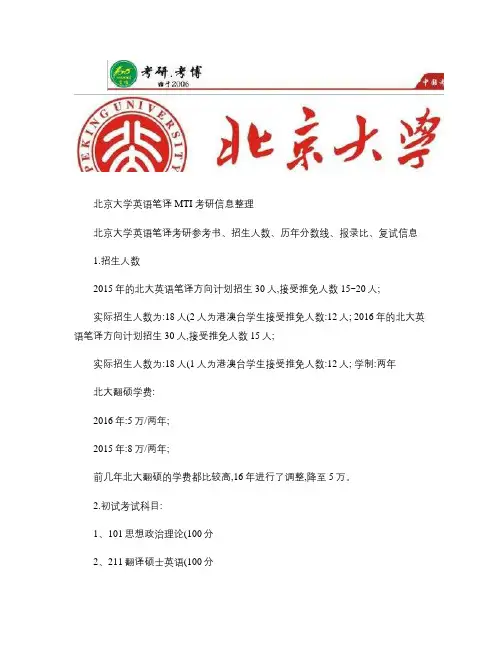
北京大学英语笔译 MTI 考研信息整理北京大学英语笔译考研参考书、招生人数、历年分数线、报录比、复试信息1.招生人数2015年的北大英语笔译方向计划招生 30人,接受推免人数 15~20人;实际招生人数为:18人(2人为港澳台学生接受推免人数:12人; 2016年的北大英语笔译方向计划招生 30人,接受推免人数 15人;实际招生人数为:18人(1人为港澳台学生接受推免人数:12人; 学制:两年北大翻硕学费:2016年:5万/两年;2015年:8万/两年;前几年北大翻硕的学费都比较高,16年进行了调整,降至 5万。
2.初试考试科目:1、101思想政治理论(100分2、211翻译硕士英语(100分3、357英语翻译基础(150分4、448汉语写作与百科知识(150分★★★育明宋老师解析:北大英语 MTI 只有笔译一个方向,初试除了思想政治理论是全国统一试卷, 剩下的三门专业课, 都是北大自主出题, 出题的整体方向都偏文学性, 特别指出的是, 北大英语 MTI 和日语的 MTI 的专业课汉语写作与百科知识,考的是同一张试卷,分为基础知识(100分和专业知识(50分两部分,满分 150分.北大考研(翻译技巧——形容词的翻译形容词与比较级形容词的第三大难点即形容词比较级的翻译,说到这里,很多小伙伴不以为然,不就是“比…更…” 吗,但是,你要相信考试的时候是不会出“this stick is longer than that one”这类弱智句子的, 下面我们一起来缕缕这些时常困扰着我们的比较级~1, “比较级+than”结构,这类句式比较常见,在翻译时,要先翻译 than 后面的内容,如:①Marseilles has proved to be a better racial melting pot than Lyons.事实证明,与里昂相比,马赛是一个更好的种族大熔炉。
②She’s much happier performing live than in a recording studio.与在录音棚里录音相比,她更喜欢现场表演。
2018年北外MTI翻译基础真题
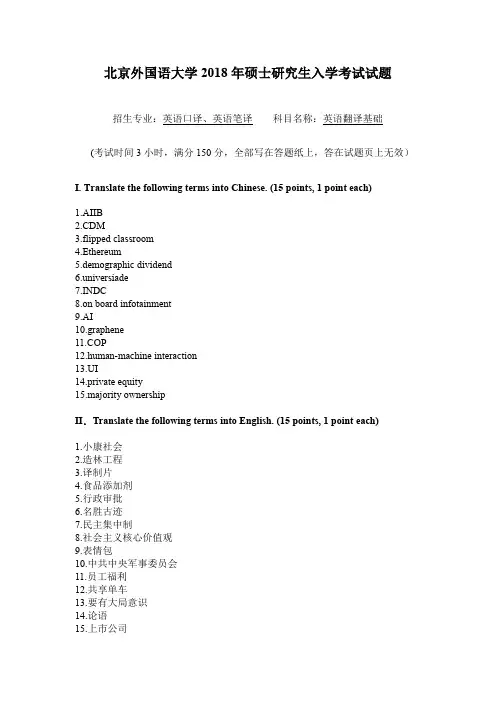
北京外国语大学2018年硕士研究生入学考试试题招生专业:英语口译、英语笔译科目名称:英语翻译基础(考试时间3小时,满分150分,全部写在答题纸上,答在试题页上无效)I. Translate the following terms into Chinese. (15 points, 1 point each)1.AIIB2.CDM3.flipped classroom4.Ethereum5.demographic dividend6.universiade7.INDC8.on board infotainment9.AI10.graphene11.COP12.human-machine interaction13.UI14.private equity15.majority ownershipII.Translate the following terms into English. (15 points, 1 point each)1.小康社会2.造林工程3.译制片4.食品添加剂5.行政审批6.名胜古迹7.民主集中制8.社会主义核心价值观9.表情包10.中共中央军事委员会11.员工福利12.共享单车13.要有大局意识14.论语15.上市公司III.Translate the following passage into Chinese. (60 points)A survey of rural in- and out-of school young people towards agriculture, based on field-work in two regions in Ethiopia, is remarkably rich and insightful. Life as a farmer was tied to life in a village which most respondents saw as hard and demanding. Yet there was considerable heterogeneity in the views of the young. Participants in both regions concurred that agriculture has changed significantly over the last decade. The introduction and adoption of agricultural inputs such as improved seeds, fertilisers and better farming methods have produced significant increases in productivity and earnings.There were competing narratives on whether agriculture was becoming more desirable to young people as a result. Participants felt that these developments were making agriculture more and more profitable and therefore more appealing. But they felt that there was a huge obstacle in engaging in it – scarcity of land. Although the dominant view was that young people are disinterested in agriculture, some participants pointed out that this was not always the case.A slightly more positive attitude towards agriculture was evident among young people who had left school, either failing to complete high school for various reasons or to qualify for higher level education. Although this group of respondents were equally aware of the grimness of traditional agriculture and the life of the common farmer, many were not dismissive of agriculture as a possible future livelihood, while a few even saw it as a preferred livelihood option, under improved conditions.IV. Translate the following passage into English (60 points)这个依山而建、占地1.3公顷的北京园,由三进庭院组成,融汇了皇家园林的精华,包括幽雅的宫廷园、富丽大气的山水园、含蓄内敛的山地园,处处彰显了皇家园林富丽典雅的气质。
北京外国语大学(357)英语翻译基础2018年真题
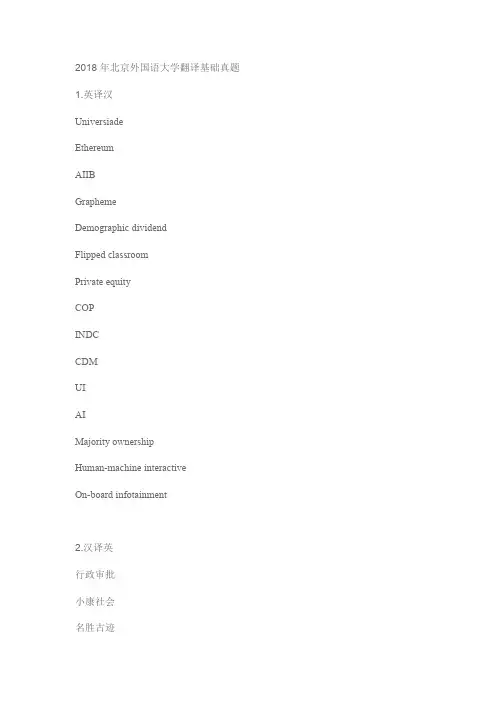
步入北京园的第一进院,是个四合院式的宫廷园林,依景种植松石、翠竹,还有 以白色花卉为主的牡丹、玉兰、海棠,体现了幽静、典雅的宫廷氛围;第二进院 是自然与人工交汇的山水园,突显堂皇大气,是全园景观的经典;第三进院则是 一处既含蓄又内敛的皇家山地园,北京园的主要建筑万象昭辉就坐落于此。
万象昭辉是北京园的最高点,拾阶而上,登上高处,园内的方池、书楼、廊榭、 亭台、石桥,尽收眼底;放眼园外,可看见京石铁路上的高铁列车飞驰而过,仿 佛预示着繁荣的过去与快速发展的今天。
2018 年北京外国语大学翻译基础真题 1.英译汉 Universiade Ethereum AIIB Grapheme Demographic dividend Flipped classroom Private equity COP INDC CDM UIБайду номын сангаасAI Majority ownership Human-machine interactive On-board infotainment
There were competing narratives on whether agriculture was becoming more desirable to young people as a result. Participants felt that these developments were making agriculture more and more profitable and therefore more appealing. But they felt that there was a huge obstacle in engaging in it —scarcity of land. Although the dominant view was that young people are disinterested in agriculture, some participants pointed out that this was not always the case.
2018年北京师范大学翻译硕士英语笔译考研真题及解析、备考难度分析、参考书目
2018年北师翻译硕士英语(笔译)考研备考信息、参考书目、专业课分析讲解近几年北师分数线走势:年份专业代码及名称政治理论外国语业务课一业务课二总分招生人数2012(0551)翻译5050909033020 2013055101英语笔译50609510035025 2014055101英语笔译506010010034025 2015055101英语笔译5060909034070 2016055101英语笔译5060909033070 2017055101英语笔译5060909034070年北京师范大学翻译硕士考研参考数目:关于参考书目的问题北师大在15年前面还会公布参考书目以及参考资料,但是16年就没有在进行公布。
针对报考北师大的翻硕的问题,北师大属于综合类型偏师范院校,是985、211院校;北师大的翻硕只有英语笔译这一方向;而且每年招生的人数也比较多,15年进行扩招之后,每年招生人数就达到70人,所以是英语本专业或者非本专业的,学习较好的都可以报考北师大的;关于参考书目,其实不给定参考书目也没问题,参考书目也只是一个学习的范围,也比较零乱,不容易具体精炼的复习,所以也不容易发挥,根本达不到应试的要求;关于分数线的降低,主要是因为人数扩招,所以会考虑到人数的问题;再就是学生的分数普遍偏低,或者是单科不过线,这些都是引起分数线下降的原因。
推荐参考书目:1.庄绎传,《英汉翻译简明教程》北京:外语教学与研究出版社,20022.叶子南,《高级英汉翻译理论与实践》北京:清华大学出版社,20013.张汉熙,《高级英语》(修订本)第1、2册北京:外语教学与研究出版社,19954.张卫平,《英语报刊选读》北京:外语教学与研究出版社,20055.张岱年,《中国文化概论》北京:北京师范大学出版社,2004、20106.夏晓鸣,《应用文写作》上海:复旦大学出版社,20107.《全国翻译硕士考研真题解析》天津科技翻译出版社8.李国正,《百科知识考点精编与真题解析》,北京:光明日报出版社,2013年。
2018年北京大学翻译硕士考研参考书,考研大纲,考研复试经验,复试分数线,录取名单
北京大学翻译硕士英语笔译考研资料-考研考博一.北京大学外国语学院英语笔译考研内容分析专业招生人数初试复试英语笔译年份/分数线统考推免政治100分翻译硕士英语100分英语翻译基础150分汉语写作与百科知识150分复试时间一般在3月中下旬。
复试实行差额复试,择优录取。
复试形式分为笔试和面试(主要考查翻译能力及专业准备,面试时的工作语言为英语)。
考生的外语听力考试在复试中进行,并计入复试总成绩。
2017/35019112016/30515152015/3301020二、2017年录取名单北京大学外国语学院2017年接收英语笔译专业免试推荐研究生初取名单姓名复试成绩专业1周一帆91.2英语笔译2谢万容87.6英语笔译3陈尚敏86.8英语笔译4孙一冰86.6英语笔译5李晟泽85.2英语笔译6程芷薇83.8英语笔译7路妍桢82.8英语笔译8刘洋82英语笔译9房一品81.6英语笔译10张艾嘉81英语笔译11王瑞79.6英语笔译二.育明考研考博辅导中心孙老师解析:关于北京大学翻译硕士英语笔译2017年的招生信息最新总结:1,北京大学2017年英语笔译复试分数线350,历史最高。
很多同学单科线不过,导致无缘复试。
北大是自主划线的,根据学生的考试情况和招生人数决定。
翻译硕士现在报考和招生的人数都在增加,高分也越来越多,17年的分数线比前几年都高,也说明了这个问题。
所以18年的考生要提早准备。
2,北京大学英语笔译招生人数30人,推免生17年有原来的20变到现在的11人,统招19人,具体人数要根据总人数和推免人数决定。
3,北京大学英语笔译的学费这几年一直增加,后来增加到两年8万,但是鉴于同学们反映强烈,北大现在适当的调整到2年5万元,所以这些不是同学考研的重要因素的,育明教育孙老师希望大家根据正确的方向认真备考。
4,北京大学英语笔译参考书真题都不公布,很多考生觉得无从下手,但是没有参考书并不能阻碍什么。
考研,非参加知识竞赛,背书即可。
2018年国际关系学院翻译硕士(MTI)汉语写作与百科知识真题试卷(题
2018年国际关系学院翻译硕士(MTI)汉语写作与百科知识真题试卷(题后含答案及解析)全部题型 3. 名词解释5. 应用文写作名词解释1.至于对文化的结构,一般把它分为四个层次:一为物态文化层;二为制度文化层;三为行为文化层;四为心态文化层。
正确答案:(1)物态文化层:指人的物质生产活动及其产品的总和,是看得见摸得着的具体实在的事物,如人们的衣、食、住、行等。
(2)制度文化层:指人们在社会实践中建立的规范自身行为和调节相互关系的准则。
2.中国的自然地势是西高东低。
高原和丘陵差不多占了三分之二,有四大高原,都集中于西部和北部。
丘陵和平原则分布于东部,有所谓四大平原。
正确答案:(1)四大高原:指青藏高原、内蒙古高原、黄土高原、云贵高原。
青藏高原平均海拔4 000米以上,被称为“世界屋脊”。
内蒙古高原为中国第二大高原,是全国著名的畜牧业基地。
黄土高原水土流失严重,是黄河泥沙的主要来源地。
云贵高原平均海拔1 000米~2 000米。
石灰岩地形分布广,是世界上岩溶地貌发育最典型的地区之一。
(2)四大平原:指东北平原、华北平原、长江中下游平原和珠江三角洲平原。
3.许慎《说文解字》一书,系统分析了汉字的六种结构,学术上称为“六书”。
我国古代的图书分类自汉代“七分法”之后,到晋代产生了“四分法”。
后来《隋书-经籍志》著录了东汉以来的大量文献,并按四部分类,从此有了“四部”之称。
正确答案:(1)六书:是古人分析汉字的造字法而归纳出来的六种条例,即象形、指事、会意、形声、转注、假借。
前四者指汉字的形体结构,后两者指汉字的使用方法。
(2)四部:即经、史、子、集,是我国古代图书分类的名称,又称“四部分类法”“四库分类法”“四分法”。
其在我国通行千余年,被许多史志、官簿及私人藏书目录用作分类依据,对古典文献的保管和流通起过一定的积极作用。
4.古时祭祀以“五岳”“四海”等最为重要,因为它们代表了帝王统治的江山社稷。
我国古代现存的历史名楼,确实都在山水胜地。
2018年考研北京大学计算机辅助翻译专业真题回忆
2篇英译汉,22篇汉译英,最后一个编译题(50分)。
英汉互译忘了具体多少了,大概55开。
英译汉第一个(20分):讲的是:地理环境对发音的影响。
不难,第二个(25分):特朗普拉拢选民的事情,具体没搞懂,瞎翻的(之前根本没准备过政治类的翻译,打脸了,,)汉译英是出的一篇文章,节选的句子和小段落的翻译。
汉译英第一个(25分):地理气候的寒冷或者干燥对居民发音的影响?记不清了,感觉跟英译汉第一个混了。
第二个(30分):最后写的这个题目。
将的是人工智能(机器翻译)对翻译行业的影响。
得出的结论是:机器翻译不会替代人工,但是会摧毁这个行业。
考的是这个专业,做到这样的题目。
感觉很讽刺。
最后一篇摘译题:讲述的是有关阿里巴巴的事情。
题目要求:不能顺序摘译原文,要命题,写作文,有自己的论点论据。
论据必须使用原文的内容。
字数400-600.多了或者少了都要扣分,,总共有3篇文章。
总的来说,题目不是很难,自己理一理思路,写出来一篇文章不是很难的。
第一篇:讲述的是阿里巴巴的在数据信息方面的优势。
既有淘宝天猫的海量用户数据,又有线下的商超和打车?的数据。
这让阿里很有竞争优势。
而且阿里的创新精神代表国家的创新驱动的战略,得到国家的支持。
海外国家的类似的公司却不能这样得到海量的私人数据信息,对阿里羡慕嫉妒恨。
第二篇:讲述的是印度电商PayTM的创始人XXX出生在一个距离新德里一百多公里的偏僻农村,上的大学是印度理工学院?,然后偶然间接触到马爸爸,然后自己思考可以借鉴阿里巴巴在中国的成功,吧这种模式搬到印度去。
结果拿到了阿里的投资,然后就不拉不拉,,,称为印度比较领先的电商公司。
后面没有资金了还是找的马爸爸来融资的,并表示,当今移动互联网的时代,不用像以往一样,看西方国家的先进之处,而是要看东方,看中国。
第三篇:讲述的是阿里投资东南亚某电商公司的情况。
阿里是其最大的股东。
并且增持了后者的股票。
从50+%增持到90+%。
该公司在东南亚市场很有竞争力,在投入运营的6个东南亚国家中,其中有5个国家都是最主要的竞争者。
- 1、下载文档前请自行甄别文档内容的完整性,平台不提供额外的编辑、内容补充、找答案等附加服务。
- 2、"仅部分预览"的文档,不可在线预览部分如存在完整性等问题,可反馈申请退款(可完整预览的文档不适用该条件!)。
- 3、如文档侵犯您的权益,请联系客服反馈,我们会尽快为您处理(人工客服工作时间:9:00-18:30)。
2018真题回忆:
翻译硕士英语
* 完型
论文摘要一篇:
主要内容:从耻辱感到罪恶感
考核单词、词组、连接词文章理解
* 阅读四篇
第一篇
围绕一个人文主义作家,讲古典文学创作传统的隐晦和强调神的地位受人文主义影响后的变化
第二篇
缺乏封建传统使得美国工人运动乏力
第三篇
美国国会未能降低赤字,作者对两党的批评
第四篇
翻译起源于对希腊语和拉丁语的教学,这一传统对后来研究的阻碍作用
* 排序五题
茶叶党的文化特征和对宪法的不坚定性
一个已给出,一个多余
* 作文
交际翻译和语义翻译哪个更好
翻译
*词条
1. 举债融资
2. 产能
3. 淡季
4. 京津冀一体化
5. 动车
6. 自媒体
7. 创新示范区
8. 中华民族伟大复兴
9. 宏观政策
10. 供给侧改革
11. 新常态
12. 陪产假
13. 男女平等
14. 打车软件
15. 低头族
16. UNICEF
17. Ganges
18. Think tank
19. Passover
20. The Bastille
21. Glucose
22. Republicanism
23. surrealism
24. procrastination
25. tipping point
26. Chiang Kai-shek
27. Kilimanjaro
28. avant-garde
29. Notre Dame de Paris
30. Academy Reward
英译汉
话题:历法
汉译英
话题:生态文学
百科
1.25个选择(每个一分)
实在记不全,都是参考书里的,西方哲学、翻译理论、翻译项目管理、《中国翻译》上的文章都有考。
记得的有:
下面哪个关于“逻各斯”的说法不对
文化翻译的原则
《弗兰恩斯坦》的作者
傅雷翻译观
第五次科技革命的成果
中国翻译发展的特点
大数据的特点
2. 论述(每个5分)
最后5个选择完还要用300字回答提问
1.《华夏集》的作者、翻译理念、写作背景
2.《钦定本圣经》的修订背景、影响
3.鲁迅和维努狄异化翻译观的异同
4.对等翻译理论是谁提出的,内容?
5.当代中国翻译在海外出版的不足和建议
3.小作文
给日语翻译公司的求职自荐信
4.大作文
共享经济。
